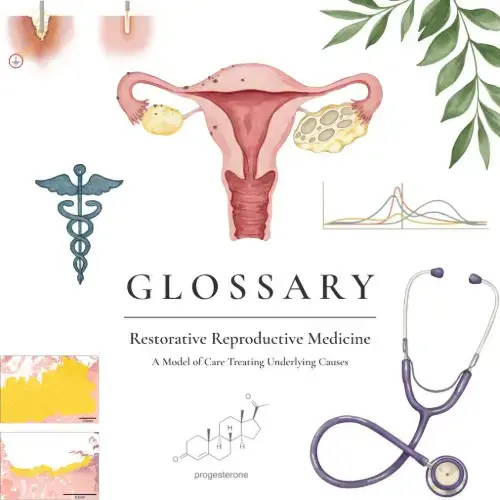Understanding PCOS: A Personal Journey of Healing Through RRM and Lifestyle
- Naomi Whittaker, MD

- May 23
- 5 min read
Updated: Jul 2

“I always had irregular periods—four times a year, like clockwork. At 18, they became less predictable. By 20, they were less frequent, heavy, and painful. At 25, despite an active lifestyle and healthy diet, they disappeared entirely—along with any clear signs of cycling. That’s when I began the long road to a PCOS diagnosis.”
Too many women walk a confusing and lonely road with their reproductive health—especially when conditions like Polycystic Ovary Syndrome (PCOS) are involved. This story, shared with us by one of our community members, captures the disjointed, exhausting yet ultimately hopeful journey that so many women face.
The Invisible Battle of “Not Normal”
Polycystic Ovary Syndrome, or PCOS, affects the lives of 1 in 10 women of reproductive age, according to the CDC. If you are walking this path, you know deep down that it is more than just a clinical diagnosis. It includes irregular cycles, painful periods, hormonal imbalances, unexplained weight changes, and mood swings. Women may also face the heartache of infertility, along with the sharp sting of questioning if this hardship is simply "how your body is."
Stories like this are not uncommon. Women, like one I think back on, whose first hints came early—long irregular cycles that were strangely rhythmic. “Four periods a year,” she recalled. “It didn’t feel right, but it was my normal.” When the pattern changed in her late teens and early twenties, doctors offered few answers.
A Missing Diagnosis—and a Delayed Healing
Sadly, delayed diagnosis is common with PCOS. A study by Gibson-Helm (2017) reports that many women struggle for years before getting diagnosed, especially when their symptoms don’t fit neatly into textbook boxes.
In this case, the disappearance of her period finally prompted a deeper investigation. A hard-fought diagnosis confirmed PCOS—but instead of relief, it opened more questions.
“I was already living a clean lifestyle,” she shared. “I didn’t have classic signs of insulin resistance. No one could tell me why things had gotten worse or how to fix it.”
It wasn’t until another piece of the puzzle surfaced—persistent, come-and-go GI pain starting when she was 23—that the root causes began to come into focus.
The Celiac Surprise: When One Diagnosis Unlocks Many
By age 28, the nagging GI pain had become more intense. After years of "everything looks normal" bloodwork and generic suggestions (“Maybe you’re just sensitive to dairy”), a determined GI specialist finally ran a comprehensive panel. The results? Celiac disease.
“It was a shock,” she said, “but it made so much sense.”
Celiac disease is an autoimmune condition where eating gluten damages the small intestine. It impairs nutrient absorption and can wreak havoc on multiple body systems—especially reproductive health. Research has shown that undiagnosed celiac can contribute to irregular cycles, infertility, and even early menopause in some women.
This diagnosis was a turning point. It came not through a pill or procedure, but through understanding her body.
Functional Nutrition and RRM: A Restorative Approach to Living with PCOS
Armed with a celiac diagnosis, she began working with a functional nutritionist—someone trained to connect the dots that standard medicine often misses. What they found was eye-opening:
Exocrine Pancreatic Insufficiency (EPI)—her pancreas wasn’t producing enough enzymes to digest fats and proteins.
Liver Dysfunction—likely driven by years of poor nutrient absorption and inflammation.
Micronutrient Deficiencies—including key vitamins and minerals essential for hormone production.
This is where Restorative Reproductive Medicine (RRM) shines. Unlike symptom-focused protocols that treat irregular periods with birth control or overlook subtle signs of dysfunction, RRM seeks to restore the body’s natural cycles by identifying and treating the root causes.
As she began addressing her gut health, supporting her pancreas and liver, and restoring key nutrients, something noteworthy happened:
“I started seeing my cervical mucus cycle again. I’m temporarily using topical progesterone to support regular bleeding. The changes in my skin, mood, and bowel movements have been huge.”
For the first time in years, she was cycling.
Why Charting Matters—Even When You’re “Not Cycling”
One of the most empowering tools in her journey was learning how to observe and chart her biomarkers—particularly cervical mucus, which reflects hormonal shifts and ovulatory health.
Many women with PCOS are told they don’t ovulate or that their cycles are too irregular to track. But in RRM, subtle patterns often emerge when women are taught what to look for.
Her ability to observe the return of cervical mucus was a significant win—not just diagnostically, but emotionally.
“It gave me hope. It was tangible evidence that my body could heal.”
For women interested in learning how to chart their cycles with scientific accuracy, organizations like FertilityCare Centers of America, FACTS, and FEMM offer education and certified instructors.
RRM vs. Symptom Suppression
Many women find RRM after years of being dismissed, medicated, or moved through a medical model designed to suppress symptoms hurriedly.
The Restorative Reproductive Medicine model offers a different path—one that seeks healing, not suppression. RRM doesn't mask irregular cycles with synthetic hormones. We don’t dismiss GI symptoms as “unrelated.” We reject the notion of pathologizing a woman’s body just because it doesn’t fit the 28-day template.
Instead, we ask:
What is your body telling you?
What systems are under stress?
What can we do to support—not override—your natural rhythms?
In her case, RRM offered what the rest of the system didn’t: a comprehensive, patient-centered, data-informed path toward real healing.
Three Takeaways for Women Facing PCOS
This story isn’t an outlier. It highlights the pressing need for a shift in how we view women’s health— particularly with complex conditions like PCOS, celiac disease, and hormonal dysfunction.
Here’s what her journey teaches us:
Don’t settle for “normal enough.” If your cycle feels off, painful, absent, or unexplainable—keep asking questions. Your body is providing data. RRM can help you interpret it.
Healing is often systemic. PCOS doesn’t exist in a vacuum. Gut health, liver function, stress, and nutrient status all play a role. A holistic approach is essential for effective treatment.
RRM works because it aligns with the body's design. By restoring—not replacing—reproductive function, RRM empowers women to live in accordance with their biology, not in battle with it.
A New Path Forward
At RRM Academy, we are cultivating a restorative medical culture—one that listens to women, investigates the body's biomarkers as valuable data, and supports healing with science and compassion.
Whether you’re navigating PCOS, trying to conceive, managing chronic conditions, or seeking to understand your cycle better, remember that healing is possible.
Access a wealth of information in our Research Library and follow Dr. Whittaker on IG for studies and articles on various reproductive health topics.


Comments